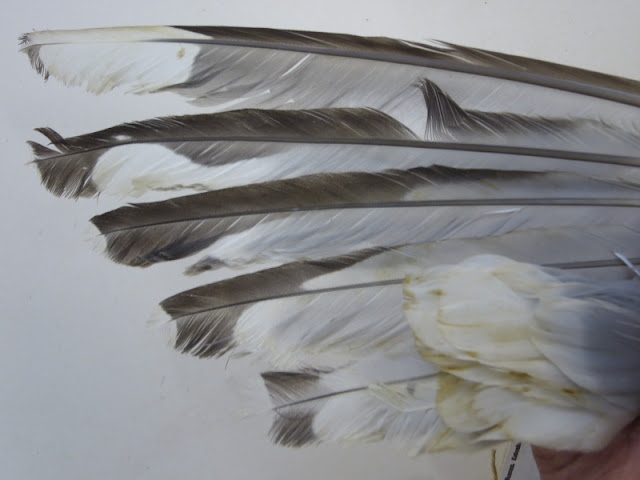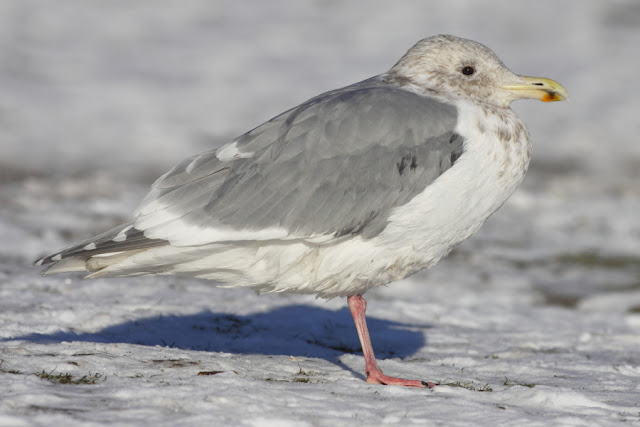Thursday, 31 January 2013
Black-headed Gull (Larus ridibundus) with pale median coverts
This 2cy Black-headed Gull was seen near Aarhus University on February 9, 2012. Note that the outer tertial is new grey; and the majority of the greater and median coverts are new grey with the medians showing only a faint brownish tinge. Especially the unmarked median coverts are not typical for the age class in February.
Sunday, 27 January 2013
Sexual size dimorphism in Thayer's Gull is significant
Last week I spend two days at the Zoological Museum Copenhagen where they have one of the largest tissue collections of birds in the world. While working my way through different topics I came across the large gull species where a male-type Thayer’s Gull immediately attracted my attention - it is the same individual in all the photos. I was struck by its impressive head and bill, but also its apparently large size compared to the argentatus Herring Gulls in the tray next to it. This reminded me of all the people I have heard talking about how they normally consider thayeri to be a relatively small and petit species. I think the literature is to blame for this rift as our current field guides don't give the impression that there is a high degree of dimorphism between sexes in Thayer’s Gull unless you evaluate the measurements.
Another thing that called for attention was the apparent shape of the nostrils. I have looked at this character before without being able to conclude its relative importance when identifying Thayer's Gull, but again I was surprised to see that even though there were not many thayeri in the museum collection, all had the same nostril shape where the rear end is very narrow and unlike what I regularly see in Herring Gulls. I think this is worth evaluating. Does Herring Gull have a more widely open nostril compared to a narrower one in Thayer's Gull just like most Caspian Gulls and also some of the Glaucous Gulls I have assessed? Future will tell whether this micro character is of any significance...
When evaluating measurements in “Gulls of North America, Europe and Asia” by Olsen & Larsson, a high degree of size variation among the larger species is apparent. There is significant variation between species, but also within and between sexes of the same species. The measures in table 1 represent the extreme values from skinned adult birds of both male and female.
It is obvious that Thayer’s Gull overlap with most of the larger gull species in the list and even significantly so with the five medium sized species such as American Herring Gull, European Herring Gull, Lesser Black-backed Gull, Kumlien's Gull and Iceland Gull. The weight of female Thayer’s is higher than that of male Kumlien’s which supports the more robust structure in Thayer’s
From the standard measures for adults (again with sexes combined) in “Gulls of the Americas” by Howell & Dunn an obvious overlap (often extensive) in also apparent in most characters among similar species (table 2):
Zimmer wrote in 1990 (in ‘The Thayer's Gull Complex’, Pp. 114-130 in ‘A Field Guide to Advanced Birding’ by Kenn Kaufman): ‘I believe that our ideas regarding what a 'classic' Thayer's Gull should look like (structurally) are based primarily on the appearance of female Thayer's. (...) With Thayer's, intersexual differences can be dramatic’. This bias can temper our analysis of birds in the field and on photos
Another thing that called for attention was the apparent shape of the nostrils. I have looked at this character before without being able to conclude its relative importance when identifying Thayer's Gull, but again I was surprised to see that even though there were not many thayeri in the museum collection, all had the same nostril shape where the rear end is very narrow and unlike what I regularly see in Herring Gulls. I think this is worth evaluating. Does Herring Gull have a more widely open nostril compared to a narrower one in Thayer's Gull just like most Caspian Gulls and also some of the Glaucous Gulls I have assessed? Future will tell whether this micro character is of any significance...
 |
| Adult Thayer's Gull male, Danish Thule and Ellesmere Land Expedition 1939-40. Specimen found at Zoological Museum Copenhagen. Note that the rear end of the nostril is very narrow |
When evaluating measurements in “Gulls of North America, Europe and Asia” by Olsen & Larsson, a high degree of size variation among the larger species is apparent. There is significant variation between species, but also within and between sexes of the same species. The measures in table 1 represent the extreme values from skinned adult birds of both male and female.
Wing
|
Bill
|
Weight
|
|
Great Black-backed
Gull
|
445-520 mm
|
53.9-66.7 mm
|
732-2275 g
|
Glaucous-winged Gull
|
392-480 mm
|
46.4-64.3 mm
|
820-1690 g
|
Glaucous Gull ssp. hyperboreus
|
408-501 mm
|
50.2-69.1 mm
|
964-2215 g
|
Glaucous Gull ssp. barrovianus
|
414-484 mm
|
49.0-65.5 mm
|
-
|
Glaucous Gull ssp. pallidissimus
|
436-472 mm
|
56.3-70.0 mm
|
-
|
Iceland Gull
|
379-443 mm
|
36.3-53.5 mm
|
480-1039 g
|
Kumlien's Gull
|
380-442 mm
|
38.8-50.6 mm
|
530-970 g
|
Thayer’s Gull
|
384-442
mm
|
44.0-55.5
mm
|
712-1002
g
|
American Herring
Gull
|
412-468 mm
|
44.2-62.1 mm
|
600-1650 g
|
European Herring
Gull ssp. argentatus
|
385-480 mm
|
43.9-65.2 mm
|
717-1525 g
|
European Herring
Gull ssp. argenteus
|
381-460 mm
|
44.4-63.9 mm
|
600-1150 g
|
Slaty-backed Gull
|
406-479 mm
|
48.4-64.6 mm
|
-
|
Lesser Black-backed
Gull ssp. graellsii
|
383-456 mm
|
45.5-57.2 mm
|
620-1100 g
|
Table 1. Source: “Gulls of North America, Europe and Asia” by Olsen & Larsson
It is obvious that Thayer’s Gull overlap with most of the larger gull species in the list and even significantly so with the five medium sized species such as American Herring Gull, European Herring Gull, Lesser Black-backed Gull, Kumlien's Gull and Iceland Gull. The weight of female Thayer’s is higher than that of male Kumlien’s which supports the more robust structure in Thayer’s
 |
| Adult Thayer's Gull in the middle between two apparent argentatus Herring Gulls. All specimens found at Zoological Museum Copenhagen |
From the standard measures for adults (again with sexes combined) in “Gulls of the Americas” by Howell & Dunn an obvious overlap (often extensive) in also apparent in most characters among similar species (table 2):
Wing
|
Bill
|
Tarsus
|
|
Great Black-backed
Gull
|
442-511 mm
|
54.0-71.7 mm
|
67-84 mm
|
Glaucous-winged Gull
|
390-455 mm
|
48.7-63.8 mm
|
60-75 mm
|
Glaucous Gull (all subspecies combined)
|
417-494 mm
|
48.6-70.0 mm
|
61-80 mm
|
Iceland Gull
|
379-435 mm
|
36.7-49.6 mm
|
50-65 mm
|
Kumlien's Gull
|
382-431 mm
|
38.5-50.1 mm
|
51-65 mm
|
Thayer’s Gull
|
380-439 mm
|
42.6-55.2 mm
|
53-68 mm
|
American Herring
Gull
|
396-458 mm
|
46.1-61.5 mm
|
56-73 mm
|
Slaty-backed Gull
|
402-465 mm
|
49.4-61.3 mm
|
60-75 mm
|
Lesser Black-backed
Gull ssp. graellsii
|
380-446 mm
|
45.0-57.9 mm
|
54-69 mm
|
Table 2. Source: “Gulls of the Americas” by Howell & Dunn
Zimmer wrote in 1990 (in ‘The Thayer's Gull Complex’, Pp. 114-130 in ‘A Field Guide to Advanced Birding’ by Kenn Kaufman): ‘I believe that our ideas regarding what a 'classic' Thayer's Gull should look like (structurally) are based primarily on the appearance of female Thayer's. (...) With Thayer's, intersexual differences can be dramatic’. This bias can temper our analysis of birds in the field and on photos
 |
| Adult Thayer's Gull male, Danish Thule and Ellesmere Land Expedition 1939-40. Specimen found at Zoological Museum Copenhagen |
 |
| Adult Thayer's Gull male, Danish Thule and Ellesmere Land Expedition 1939-40. Specimen found at Zoological Museum Copenhagen |
 |
| Adult Thayer's Gull male, Danish Thule and Ellesmere Land Expedition 1939-40. Specimen found at Zoological Museum Copenhagen |
Saturday, 19 January 2013
Iceland Gull (Larus glaucoides), 2cy, 31.3-1.4.2012, Hanstholm Harbour
 |
| 31.3.2012 |
This 2cy glaucoides was also seen on and March 30 by Henrik Haaning Nielsen.
 |
| 31.3.2012 |
 |
| 31.3.2012 |
 |
| 1.4.2012 |
 |
| 1.4.2012 |
 |
| 31.3.2012 |
 |
| 31.3.2012 |
 |
| 31.3.2012 |
 |
| 1.4.2012 |
 |
| 1.4.2012 |
 |
| 1.4.2012 |
Friday, 18 January 2013
Glaucous-winged Gull (Larus glaucescens), 7cy, 9.2.2012, University Park, Aarhus, Denmark
The Glaucous-winged Gull has been relocated three consecutive winters in the Aarhus-area following its first discovery in November 2009 where it was in its 4th-winter plumage. It was also seen briefly in December 2009 and as a 5cy in August 2010 before it became more settled and twitchable in central Aarhus by January 2012.
Iceland Gull (Larus glaucoides), 3cy, 1.4.2012, Hanstholm Harbour #2
I also photographed this Iceland Gull on February 5 in Hanstholm Harbour; however, it was seen there by other people already on January 21.
Subscribe to:
Comments (Atom)










































